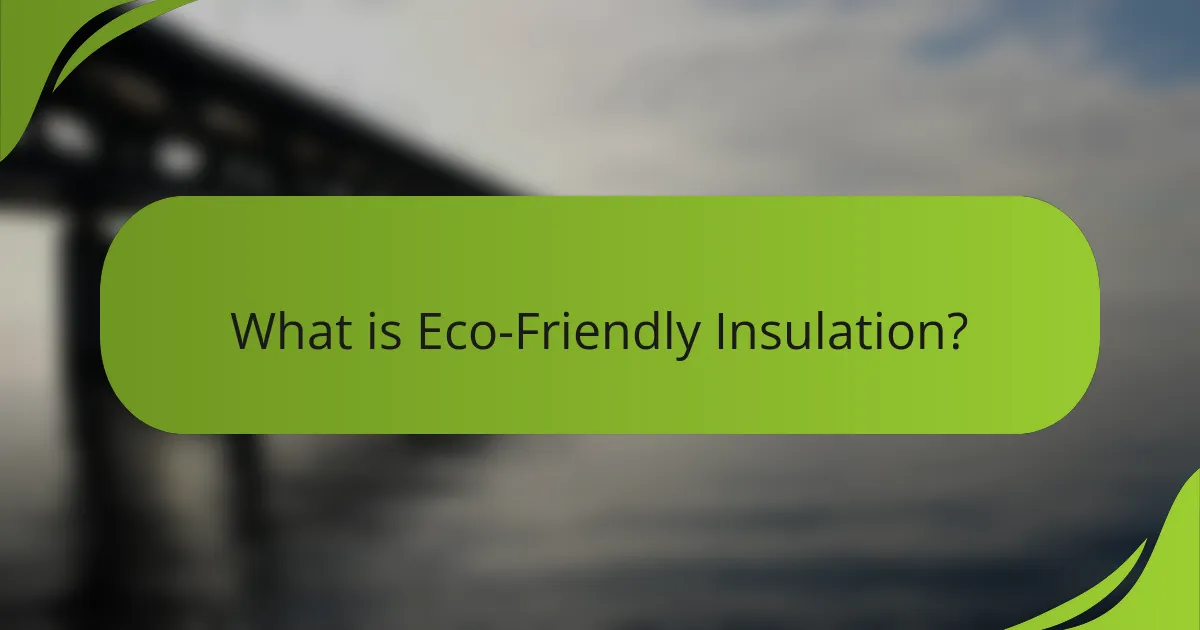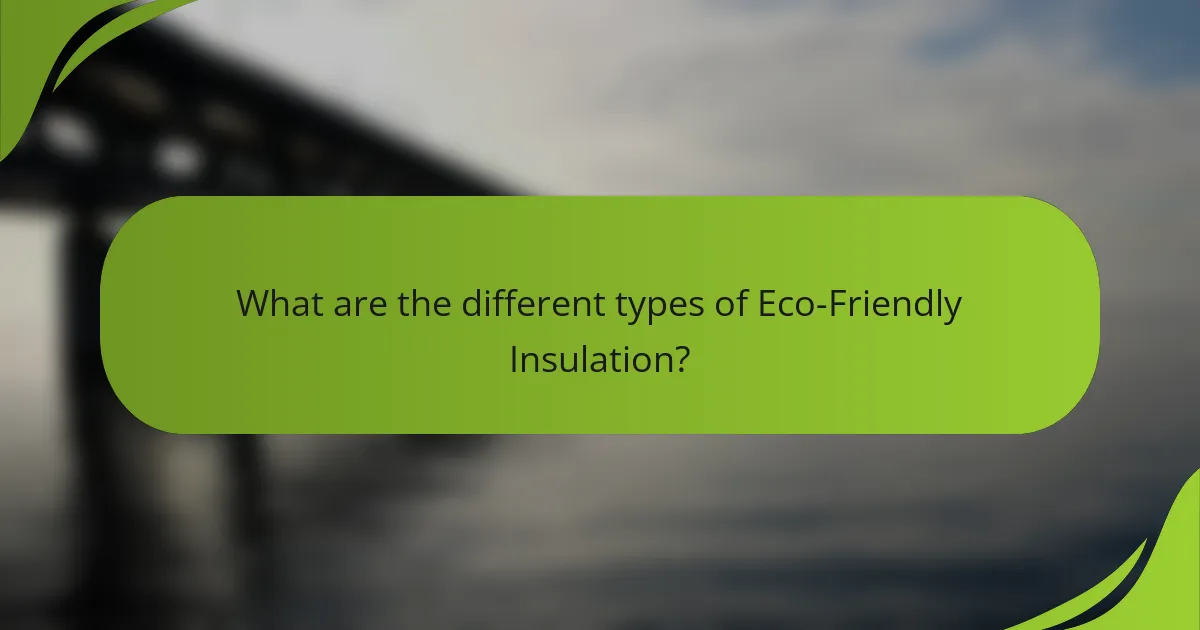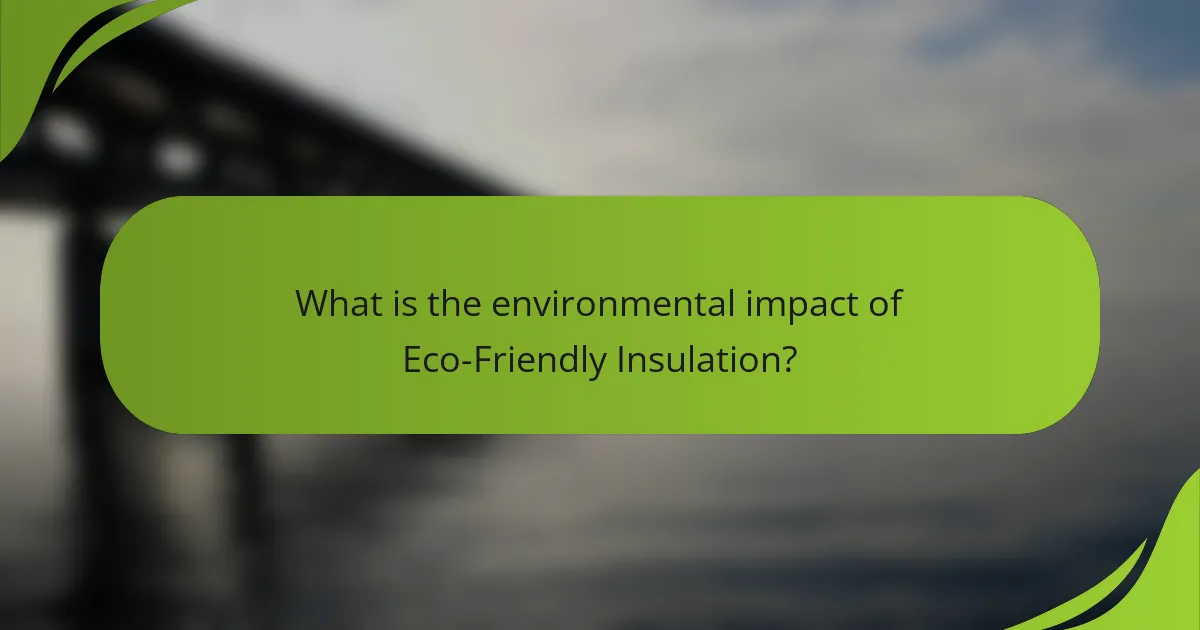Eco-friendly insulation is a sustainable building material aimed at reducing energy consumption and minimizing environmental impact. This type of insulation is composed of renewable, recycled, or non-toxic materials such as cellulose, sheep’s wool, and recycled denim, which typically have lower carbon footprints than traditional insulation options. Key benefits include improved energy efficiency, reduced heating and cooling costs, and significant decreases in greenhouse gas emissions. The article explores various types of eco-friendly insulation, their R-values, and their contributions to sustainable building practices, highlighting the positive environmental effects and advantages of using these materials in construction.

What is Eco-Friendly Insulation?
Eco-friendly insulation is a sustainable building material designed to reduce energy consumption and environmental impact. It is made from renewable, recycled, or non-toxic materials. Common types include cellulose, sheep’s wool, and recycled denim. These materials often have lower carbon footprints compared to traditional insulation options. Eco-friendly insulation can improve energy efficiency in homes and reduce heating and cooling costs. Research indicates that using eco-friendly insulation can significantly decrease greenhouse gas emissions. For example, cellulose insulation can reduce energy use by up to 20%.
How does Eco-Friendly Insulation differ from traditional insulation?
Eco-friendly insulation differs from traditional insulation primarily in its materials and environmental impact. Eco-friendly insulation uses sustainable materials like recycled cellulose, sheep’s wool, or hemp. In contrast, traditional insulation often relies on synthetic materials like fiberglass or foam, which can have a higher carbon footprint. Eco-friendly options typically offer better breathability and moisture control. They also reduce the risk of indoor air pollution, as they are less likely to emit harmful VOCs. Additionally, eco-friendly insulation often provides comparable or superior R-values, which measure thermal resistance. This means they can be just as effective at insulating while being better for the environment.
What materials are commonly used in Eco-Friendly Insulation?
Common materials used in eco-friendly insulation include cellulose, wool, hemp, and recycled denim. Cellulose is made from recycled paper and provides good thermal performance. Wool insulation is natural, renewable, and offers moisture regulation. Hemp insulation is biodegradable and has excellent thermal properties. Recycled denim insulation utilizes post-consumer waste, reducing landfill impact. These materials are sustainable choices that contribute to energy efficiency and environmental conservation.
What are the key properties of Eco-Friendly Insulation materials?
Eco-friendly insulation materials possess several key properties. They are typically made from renewable resources, reducing environmental impact. Common materials include cellulose, made from recycled paper, and sheep’s wool, which is biodegradable. These materials often have low thermal conductivity, providing effective insulation. They also tend to have low embodied energy, meaning less energy is used in their production. Many eco-friendly insulations are non-toxic and free from harmful chemicals. Additionally, they can offer excellent soundproofing qualities. These properties contribute to energy efficiency and sustainability in building practices.
Why is Eco-Friendly Insulation important for sustainability?
Eco-friendly insulation is important for sustainability because it reduces energy consumption and minimizes environmental impact. It helps maintain comfortable indoor temperatures, leading to less reliance on heating and cooling systems. This reduction in energy use decreases greenhouse gas emissions. Materials used in eco-friendly insulation, such as cellulose or sheep’s wool, are often renewable and biodegradable. According to the U.S. Department of Energy, effective insulation can lower energy bills by up to 20%. Furthermore, eco-friendly insulation contributes to healthier indoor air quality by using non-toxic materials. Overall, it plays a crucial role in promoting sustainable building practices.
How does Eco-Friendly Insulation contribute to energy efficiency?
Eco-Friendly Insulation enhances energy efficiency by minimizing heat transfer. This insulation type often has a high R-value, which measures thermal resistance. Higher R-values indicate better insulating properties. For instance, cellulose insulation has an R-value of 3.1 to 3.8 per inch, effectively reducing energy consumption. Additionally, eco-friendly materials like sheep’s wool and recycled denim are sustainable options. These materials also reduce reliance on fossil fuels for heating and cooling. Studies show that homes with proper insulation can save up to 20% on heating and cooling costs. This contributes to lower energy bills and a reduced carbon footprint.
What role does Eco-Friendly Insulation play in reducing carbon footprints?
Eco-Friendly Insulation significantly reduces carbon footprints by improving energy efficiency in buildings. It minimizes the energy required for heating and cooling. As a result, less fossil fuel consumption occurs, leading to lower greenhouse gas emissions. Materials like cellulose, wool, and recycled products are often used in eco-friendly insulation. These materials have lower embodied energy compared to traditional insulation options. Studies show that using eco-friendly insulation can reduce energy consumption by up to 30%. This reduction directly correlates with decreased carbon emissions over time. Overall, eco-friendly insulation contributes to a sustainable environment by promoting energy efficiency and reducing carbon footprints.

What are the different types of Eco-Friendly Insulation?
The different types of eco-friendly insulation include cellulose, fiberglass, sheep’s wool, cotton, and spray foam. Cellulose insulation is made from recycled paper products and has a high R-value. Fiberglass insulation is composed of recycled glass and is non-combustible. Sheep’s wool insulation provides natural moisture regulation and is biodegradable. Cotton insulation, often made from recycled denim, offers good thermal performance. Spray foam insulation can be made from renewable resources and provides an effective air seal. Each type contributes to energy efficiency and sustainability in building practices.
What are the most popular types of Eco-Friendly Insulation available?
The most popular types of eco-friendly insulation include cellulose, sheep’s wool, cotton (denim), and spray foam. Cellulose insulation is made from recycled paper products and provides excellent thermal performance. It has an R-value of around 3.2 to 3.8 per inch. Sheep’s wool insulation is natural, renewable, and offers moisture regulation. Its R-value typically ranges from 3.5 to 4.0 per inch. Cotton insulation, derived from recycled denim, is non-toxic and has an R-value of about 3.5 to 4.0 per inch. Spray foam insulation, while not entirely natural, can be eco-friendly if made with renewable resources. Its R-value can reach up to 6.5 per inch. These insulation types are gaining popularity due to their sustainability and efficiency in energy conservation.
How does cellulose insulation compare to fiberglass insulation?
Cellulose insulation is generally more eco-friendly than fiberglass insulation. Cellulose is made from recycled paper products, reducing waste and energy consumption. It has a higher R-value per inch, typically around 3.5 to 4.0, compared to fiberglass, which averages 2.9 to 3.7. This means cellulose provides better thermal resistance.
Cellulose also has superior air-sealing properties, minimizing drafts and improving energy efficiency. It is treated with fire retardants, making it safe for residential use. In contrast, fiberglass can irritate skin and lungs during installation.
Lastly, cellulose insulation can help improve indoor air quality by reducing air leakage. Studies indicate that cellulose can reduce energy costs more effectively than fiberglass over time.
What are the benefits of using sheep’s wool insulation?
Sheep’s wool insulation offers excellent thermal performance. It has a high R-value, typically around 3.5 to 4.0 per inch. This efficiency helps maintain comfortable indoor temperatures. Additionally, sheep’s wool is a natural, renewable resource. It is biodegradable and contributes to reduced environmental impact. The insulation also regulates humidity effectively. This prevents moisture buildup and mold growth. Furthermore, sheep’s wool has sound-dampening properties. It enhances acoustic comfort in buildings. Lastly, it is non-toxic and safe for indoor air quality.
How do different types of Eco-Friendly Insulation affect R-Values?
Different types of eco-friendly insulation affect R-values by varying the thermal resistance they provide. R-value measures insulation’s effectiveness in resisting heat flow. For example, cellulose insulation has an R-value of approximately 3.1 to 3.8 per inch. This is due to its dense fiber structure that traps air. Spray foam insulation offers higher R-values, ranging from 3.6 to 7.0 per inch, depending on the type. This is attributed to its ability to expand and fill gaps, creating an airtight seal. Mineral wool insulation typically has R-values between 3.1 and 3.7 per inch, benefiting from its fibrous composition. Each type of eco-friendly insulation contributes uniquely to energy efficiency and thermal performance in buildings.
What is the significance of R-Value in insulation materials?
R-Value measures the thermal resistance of insulation materials. A higher R-Value indicates better insulating effectiveness. This value is crucial for energy efficiency in buildings. It helps determine how well insulation can resist heat flow. For example, an R-Value of 30 is significantly more effective than an R-Value of 10. Proper insulation reduces heating and cooling costs. It also contributes to a comfortable indoor environment. The significance of R-Value is evident in energy codes and building regulations. These standards often require specific R-Values for different climate zones.
How do specific types of Eco-Friendly Insulation achieve high R-Values?
Specific types of eco-friendly insulation achieve high R-values through the use of materials with low thermal conductivity. These materials include cellulose, sheep’s wool, and cork. Cellulose, made from recycled paper, has an R-value of about 3.5 to 3.7 per inch. Sheep’s wool can achieve R-values between 3.5 and 4.0 per inch due to its natural air pockets. Cork, derived from the bark of cork oak trees, has an R-value of approximately 3.6 to 4.0 per inch. The effectiveness of these materials lies in their ability to trap air and reduce heat transfer. Additionally, eco-friendly insulation often incorporates renewable resources, enhancing its sustainability. This combination of low thermal conductivity and sustainable sourcing contributes to their high R-values.

What is the environmental impact of Eco-Friendly Insulation?
Eco-friendly insulation has a positive environmental impact. It reduces energy consumption in buildings, leading to lower greenhouse gas emissions. Materials like cellulose, sheep’s wool, and recycled denim are biodegradable and reduce landfill waste. Many eco-friendly insulations require less energy to produce compared to traditional options, minimizing carbon footprints. For example, cellulose insulation can save up to 30% more energy over its lifecycle. Additionally, using sustainable materials helps preserve natural resources. Eco-friendly insulation also improves indoor air quality by reducing harmful chemicals. Overall, its use contributes significantly to sustainable building practices.
How does Eco-Friendly Insulation contribute to environmental conservation?
Eco-friendly insulation contributes to environmental conservation by reducing energy consumption in buildings. It minimizes the need for heating and cooling, leading to lower greenhouse gas emissions. Materials used in eco-friendly insulation, such as cellulose and wool, are often made from recycled or renewable resources. This reduces landfill waste and the demand for virgin materials. Additionally, eco-friendly insulation often has a lower impact on indoor air quality compared to conventional options. Studies indicate that using eco-friendly insulation can decrease energy costs by up to 30%. This not only benefits homeowners but also lessens the overall carbon footprint of residential and commercial buildings.
What are the lifecycle impacts of Eco-Friendly Insulation materials?
Eco-friendly insulation materials have positive lifecycle impacts compared to traditional options. They typically require less energy for production and installation. Many eco-friendly options utilize renewable resources, reducing reliance on fossil fuels. Their production often emits fewer greenhouse gases. During use, these materials improve energy efficiency in buildings, leading to lower energy consumption. At the end of their lifecycle, they can often be recycled or biodegraded. This reduces landfill waste and environmental pollution. Studies show that eco-friendly insulation can significantly lower a building’s carbon footprint over its lifespan.
How do manufacturing processes of Eco-Friendly Insulation affect the environment?
Manufacturing processes of eco-friendly insulation generally have a lower environmental impact compared to traditional insulation materials. These processes often utilize renewable resources, such as recycled paper or plant-based materials. As a result, they reduce reliance on fossil fuels and minimize greenhouse gas emissions.
Additionally, eco-friendly insulation typically involves less energy-intensive production methods. For example, materials like cellulose require less energy to produce than fiberglass. This energy efficiency contributes to a smaller carbon footprint throughout the product’s lifecycle.
Moreover, many eco-friendly insulation products are biodegradable or recyclable at the end of their life. This characteristic reduces waste in landfills, promoting a more sustainable approach to building materials.
Research indicates that using eco-friendly insulation can lead to significant energy savings in buildings, further decreasing overall environmental impact. For instance, a study by the U.S. Department of Energy found that proper insulation can reduce heating and cooling energy use by up to 30%.
In summary, the manufacturing processes of eco-friendly insulation positively affect the environment by reducing emissions, conserving energy, and promoting sustainability.
What certifications and standards exist for Eco-Friendly Insulation?
Certifications and standards for eco-friendly insulation include Energy Star, GREENGUARD, and the Forest Stewardship Council (FSC). Energy Star certifies products that meet energy efficiency criteria. GREENGUARD ensures low chemical emissions for indoor air quality. The FSC label indicates that wood-based materials come from responsibly managed forests. Additionally, the U.S. Department of Agriculture (USDA) Organic certification applies to natural insulation products. These certifications help consumers identify environmentally friendly insulation options.
How do certifications ensure the sustainability of insulation products?
Certifications ensure the sustainability of insulation products by verifying their environmental impact and material sourcing. They assess factors like energy efficiency, recycled content, and low emissions. For example, certifications such as LEED and Energy Star provide benchmarks for sustainable practices. These certifications require compliance with strict industry standards. They also promote transparency in product claims. This helps consumers make informed choices about eco-friendly insulation. Studies show that certified products often use renewable resources and reduce overall carbon footprints. Thus, certifications play a crucial role in promoting sustainable insulation solutions.
What are the key standards to look for in Eco-Friendly Insulation?
Key standards to look for in eco-friendly insulation include sustainability, thermal performance, and low environmental impact. Sustainability refers to the use of renewable or recycled materials. Examples include cellulose made from recycled paper and wool from sheep. Thermal performance is measured by R-value, which indicates insulation effectiveness. Higher R-values signify better insulation. Low environmental impact involves minimal carbon footprint during production and disposal. Certifications such as Energy Star or GreenGuard can validate eco-friendly claims. Additionally, non-toxic materials contribute to healthier indoor air quality. These standards ensure that insulation is both effective and environmentally responsible.
What are some practical tips for choosing Eco-Friendly Insulation?
Choose insulation materials with high recycled content. Recycled denim and cellulose are good options. Look for certifications like Energy Star or GREENGUARD. These certifications ensure low emissions and energy efficiency. Consider the R-value, which measures insulation effectiveness. Higher R-values indicate better thermal resistance. Evaluate local availability to reduce transportation emissions. Finally, prioritize materials that are renewable and sustainably sourced, such as sheep’s wool or hemp. These choices contribute to a healthier environment.
Eco-friendly insulation is a sustainable building material aimed at reducing energy consumption and environmental impact through the use of renewable, recycled, or non-toxic materials. This article explores various types of eco-friendly insulation, including cellulose, sheep’s wool, and recycled denim, highlighting their R-values, effectiveness in energy efficiency, and contributions to reducing carbon footprints. It also discusses the environmental benefits of these materials, their lifecycle impacts, and the importance of certifications that ensure sustainability. Overall, eco-friendly insulation plays a crucial role in promoting sustainable building practices and improving indoor air quality.